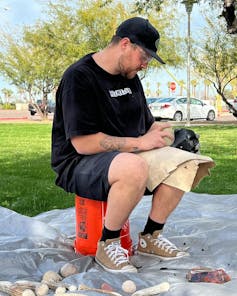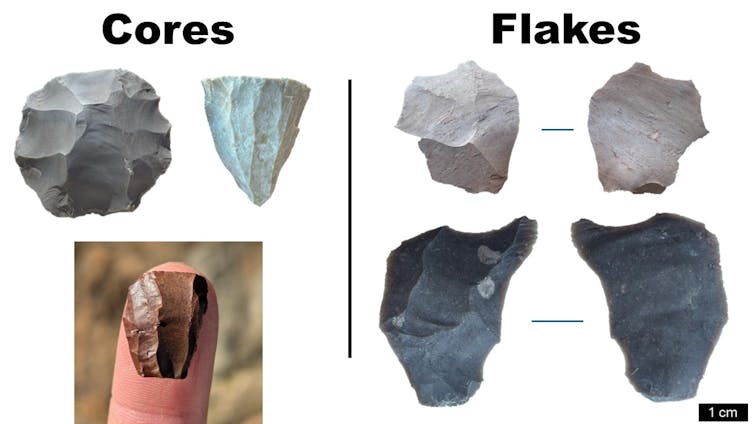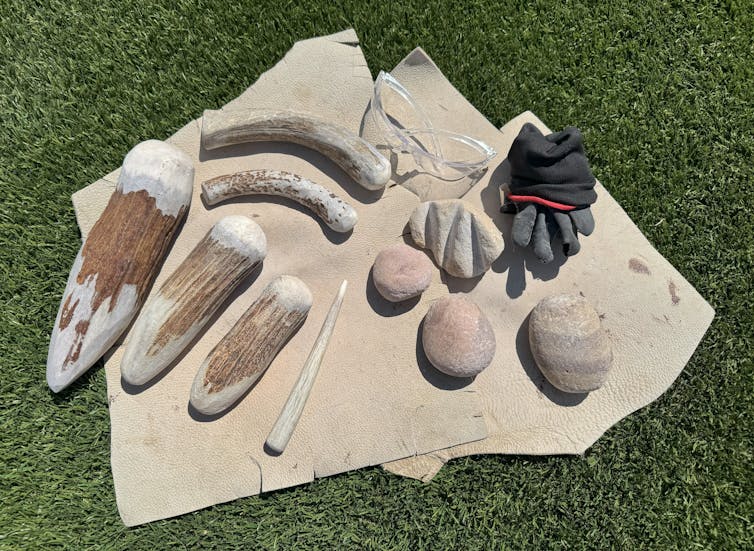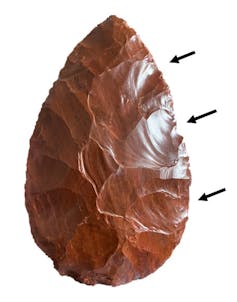Stone tools are deliberately made by the hands of hominins, like these worked on by the author. John K. Murray
Have you ever found yourself in a museumŌĆÖs gallery of human origins, staring at a glass case full of rocks labeled ŌĆ£stone tools,ŌĆØ muttering under your breath, ŌĆ£How do they know itŌĆÖs not just any old rock?ŌĆØ
At first glance, it might seem impossible to decipher. But as an experimental archaeologist with over a decade of experience studying and manufacturing stone tools, I can say that there are telltale signs that a rock has been modified by humans or our very ancient ancestors, hominins.
This process, known as flintknapping, can be boiled down to mastering force, angles and rock structure. When done properly, flintknapping creates the recognizable features that archaeologists use to identify stone tools.
A demonstration of traditional flintknapping techniques.
Why do stone tools matter?

John Murray demonstrates his flintknapping skills for the Glendale Community College Anthropology Club.
John K. Murray
Stone tools are rocks that have been selected for use or intentionally altered. This technology appeared around 3.3 million years ago and became essential to hominins ŌĆō all the living and extinct species that belong to the human lineage. Currently, we Homo sapiens are the only living hominin.
We are not the only living species to make and use stone tools, though ŌĆō many other primates do ŌĆō but the extent to which hominins modify them is unparalleled in the animal kingdom. Monkeys and other apes may hold a large stone in their hands to crack a nut on a flat, tablelike stone.
But most hominins donŌĆÖt rely on stones collected as-is. They modify and shape them into useful tools for a variety of tasks, including cutting meat or plants, woodworking, scraping hide and even as projectiles.
Stone tools are important to archaeologists because they are durable and preserve well. This makes them some of the best evidence for hominin behavior and allows us to better understand how different populations adapted to local environments across time and large geographic regions.
How are stone tools made?
Hominins manufacture stone tools by fracturing or abrading rock. Here, I am going to focus on fractured or flaked stone technology because tools made through this technique dominate the archaeological record.
The process of flaking involves applying force to the edge of a stone, known as the striking platform, through percussion or pressure to remove portions of the rock, which are called flakes. With some guidance from a teacher and plenty of practice, flintknappers can learn how to identify a promising platform on a chunk of stone, called a core, and consistently remove flakes from it. When struck, the platform is removed from the core and is a key feature of the flake.
Flakes offer an immediate sharp cutting edge. A flintknapper can also further modify them into more specific shapes for other uses. An iconic example of this is the hand ax, which is a core thatŌĆÖs been flaked into a teardrop shape.

Cores, left, are the object being struck by the flintknapper, and flakes, right, are the sharp-edged material removed from the core. Some cores, like this one from the archaeological site Pinnacle Point 5-6 in South Africa, can be as small as the tip of a finger.
John K. Murray
We often use hammerstones or large pieces of antler, called billets, to strike the coreŌĆÖs edge. Repetitive flaking not only allows a flintknapper to produce a significant amount of sharp cutting edge in the form of flakes, but gives them the ability to shape the core to their desired form ŌĆ” often with the risk of personal injury along the way. My fingers can attest to this!

A modern flintknapperŌĆÖs toolkit consists of leather pads, gloves, safety glasses, antler billets (left), hard hammerstones (right), and abraders (center-right with grooves), used to rub the edge of the stone to strengthen the platform before striking.
John K. Murray
However, not every type of rock has the characteristics needed to be flaked into a tool. You want the stone to exhibit whatŌĆÖs called conchoidal fracture. If youŌĆÖve ever seen glass break, youŌĆÖve witnessed conchoidal fracture. This smooth break, with concentric wavelike ripples, is defined by the physics of how force moves through different materials.

Obsidian hand ax made by John Murray, showcasing examples of conchoidal fracture produced while making flakes to shape it.
John K. Murray
When an experienced knapper is preparing to remove a flake, we understand how the material weŌĆÖre working will break when we strike it, so we can predict the shape and size of the tools that we are producing. A stone like obsidian, which is volcanic glass, is the poster child for conchoidal fracture.
Of course, there is a lot of variation in the quality of rock that hominins have used for manufacturing stone tools, and many have made use of lesser quality stone. Even some of the earliest toolmakers were preferentially selecting rocks for certain properties, such as durability.
How can you recognize stone tools?
You may hear people saying that rocks that they found in their garden were tools because they ŌĆ£fit perfectly in the handŌĆØ or are ŌĆ£tool shaped.ŌĆØ But itŌĆÖs not quite that straightforward. Although shape and function may play a role in the final product of a stone tool, it is not the smoking gun.
Archaeologists can determine whether a chunk of rock is a stone tool based on clues left behind from the process of conchoidal fracture during flintknapping.
One such clue is the presence of flake scars, or what we call negative removals, which can be found on both cores and flakes. These have characteristic ridges on one or more sides of the rock that outline previous flake removals ŌĆō hence the use of the term scar.
When we see multiple flake scars that are consistent in their orientation and size as opposed to being random, it is likely the stone in question was deliberately worked on by a hominin.
The second feature is what we call the bulb of percussion. This is a bulge in the flake, just below the striking platform, that results from the concentration of force when the knapper struck it.
Considering that producing a bulb of percussion requires the rock to be struck on a platform at a specific angle with enough force to detach it from the stone, it is improbable that this feature would be created through natural processes ŌĆō but not impossible. Scientists have found naturally produced sharp stone fragments, or naturaliths, all over the world, even in Antarctica.
However, when a lot of flakes with these diagnostic characteristics are found together, itŌĆÖs unlikely they were created naturally.

A hand ax made by John Murray shows many flake scars, some of which are outlined in black. The inner surface of three flakes shows the bulb of percussion just below the platform.
John K. Murray
The final thing to consider when determining whether a rock is a stone tool is the context in which it was found. Are there many stones in the area that exhibit the characteristics that we look for when trying to identify a stone tool? Is the stone tool made of an exotic material, or is it like the rest of the rocks near it?
If you find a lot of stone tools in the same area made from one type of rock, you might have stumbled across an ancient flintknapping workshop. However, if you discover a tool that was made from a type of stone that can only be found hundreds of miles away, maybe someone traded for this material or carried it with them.
Try it for yourself
I think the best way for you to be able to learn to recognize whether a chunk of stone was a tool or just a rock is to try flintknapping yourself. I have taught more than 100 people of all ages to manufacture stone tools, and most agree: It is harder than youŌĆÖd think.
This experience puts you into the minds of our hominin ancestors, trying to tackle one of the earliest problems our lineage faced: getting a sharp edge from a chunky piece of rock.
![]()
John K. Murray does not work for, consult, own shares in or receive funding from any company or organization that would benefit from this article, and has disclosed no relevant affiliations beyond their academic appointment.
ŌĆö-
Author : John K. Murray, Ph.D. Candidate in Anthropology, Institute of Human Origins, Arizona State University
Publish date : 2025-05-07 12:35:00
Copyright for syndicated content belongs to the linked Source.













